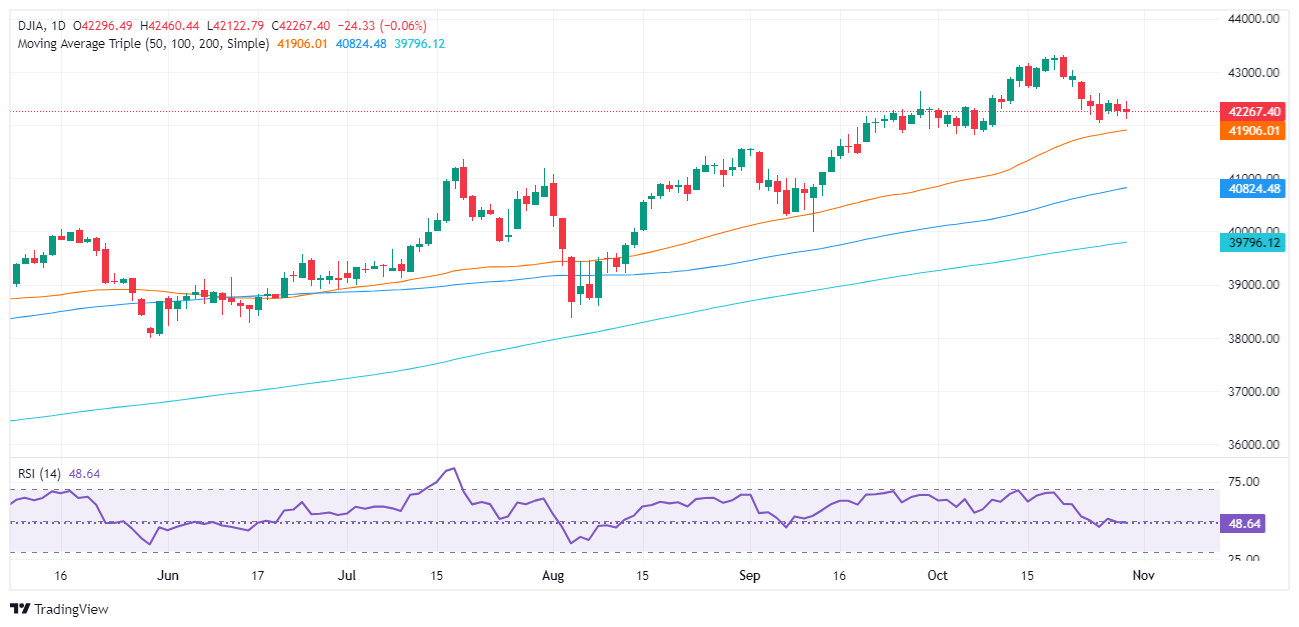Dow Jones Industrial Average advances due to strong US GDP and jobs data
- Dow Jones climbs as US economy grows 2.8% in Q3, suggesting a soft landing despite slightly missing Q2’s 3% pace.
- ADP reports hefty job gains in October, indicating robust labor demand.
- Visa leads DJIA gainers after beating earnings expectations, while Caterpillar struggles after missing EPS estimates for Q3.
The Dow Jones Industrial Average (DJIA) advanced during the North American session, with bulls eyeing a break above 42,500 as US Treasury bond yields tumbled. The economy in the US grew below estimates but at a healthy pace. At the same time, jobs data revealed by Automatic Data Processing (ADP) showed the labor market is strengthening after announcing an outstanding jobs report.
The US Bureau of Economic Analysis revealed that the economy grew 2.8% YoYin Q3 2024, according to its preliminary reading. Although it missed the mark and Q2’s 3%, the numbers suggest the economy is on its way to achieving a soft landing, as the Federal Reserve (Fed) lowers borrowing costs to stimulate the labor market.
Regarding this, the ADP National Employment Change report showed that private companies added 233K people to the workforce in October, crushing estimates of 115K. Nela Richardson, chief economist at ADP, said in a statement, “Even amid hurricane recovery, job growth was strong in October.” In the meantime, US bond yields retreated after hitting a three-month high of 4.337% and dropped 0.65% or three basis points (bps) to 4.248%.
After the data, the CME FedWatch Tool shows odds for a 25 bps rate cut by the Fed reaching 97%, down from 98% a day ago. This would leave rates in the 4.50%-4.75% range.
Dow Jones news
The earnings session continued as Visa (V) led the pack in the DJIA after the company announced fiscal Q4 2024 earnings. Visa revealed that earnings per share (EPS) was $2.71, up from estimates of $2.58, while revenue increased to $9.6 billion, exceeding forecasts of $9.48 billion. At the same time, the company cut 1,400 jobs.
Caterpillar (CAT) plunged before recovering as the company revealed lower-than-expected Q3 earnings. Adjusted earnings per share (EPS) came at $5.17, below estimates of $5.34, though revenue increased to $16.11 billion, exceeding estimates of $16.08 billion. The company projects sales and revenue to be slightly lower than expected at the end of the last quarter.
At the time of writing, Visa leads the DJIA, gaining 3.68% to $292.25. Boeing (BA) gained 2.07% to $156.14, and Amazon (AMZN) lifted 1.62% to $193.93. The laggards are International Business Machines (IBM) losing 1.95% to $206.33, followed by Nike (NKE) sinking 1.76% to $77.02, and Intel(INTC) diving 1.72% to $22.51.
Dow Jones price forecast
The Dow Jones consolidates at around 42,300 but cannot decisively crack the 42,400 mark, which would open the door to challenge 42,500.
At the beginning of the session, sellers pushed the DJIA toward a low of 42,122 near the October 25 low of 42,043, though buyers bought the dip before the index tested the 50-day Simple Moving Average (SMA) at 41,907. After that, the Dow Jones recovered some ground, clinging to minimal gains.
If buyers reclaim 42,500, look for a test of the October 23 peak at 42,830 ahead of testing 43,000 and the record high at 43,322.
Otherwise, if the Dow extends its losses below 42,000, the first support would be the 50-day SMA, ahead of 41,500.
Momentum remains bullish as depicted by the Relative Strength Index (RSI), which pierced above its neutral line. However, it has consolidated, suggesting that neither buyers nor sellers are in control.
Dow Jones daily chart

Dow Jones FAQs
The Dow Jones Industrial Average, one of the oldest stock market indices in the world, is compiled of the 30 most traded stocks in the US. The index is price-weighted rather than weighted by capitalization. It is calculated by summing the prices of the constituent stocks and dividing them by a factor, currently 0.152. The index was founded by Charles Dow, who also founded the Wall Street Journal. In later years it has been criticized for not being broadly representative enough because it only tracks 30 conglomerates, unlike broader indices such as the S&P 500.
Many different factors drive the Dow Jones Industrial Average (DJIA). The aggregate performance of the component companies revealed in quarterly company earnings reports is the main one. US and global macroeconomic data also contributes as it impacts on investor sentiment. The level of interest rates, set by the Federal Reserve (Fed), also influences the DJIA as it affects the cost of credit, on which many corporations are heavily reliant. Therefore, inflation can be a major driver as well as other metrics which impact the Fed decisions.
Dow Theory is a method for identifying the primary trend of the stock market developed by Charles Dow. A key step is to compare the direction of the Dow Jones Industrial Average (DJIA) and the Dow Jones Transportation Average (DJTA) and only follow trends where both are moving in the same direction. Volume is a confirmatory criteria. The theory uses elements of peak and trough analysis. Dow’s theory posits three trend phases: accumulation, when smart money starts buying or selling; public participation, when the wider public joins in; and distribution, when the smart money exits.
There are a number of ways to trade the DJIA. One is to use ETFs which allow investors to trade the DJIA as a single security, rather than having to buy shares in all 30 constituent companies. A leading example is the SPDR Dow Jones Industrial Average ETF (DIA). DJIA futures contracts enable traders to speculate on the future value of the index and Options provide the right, but not the obligation, to buy or sell the index at a predetermined price in the future. Mutual funds enable investors to buy a share of a diversified portfolio of DJIA stocks thus providing exposure to the overall index.